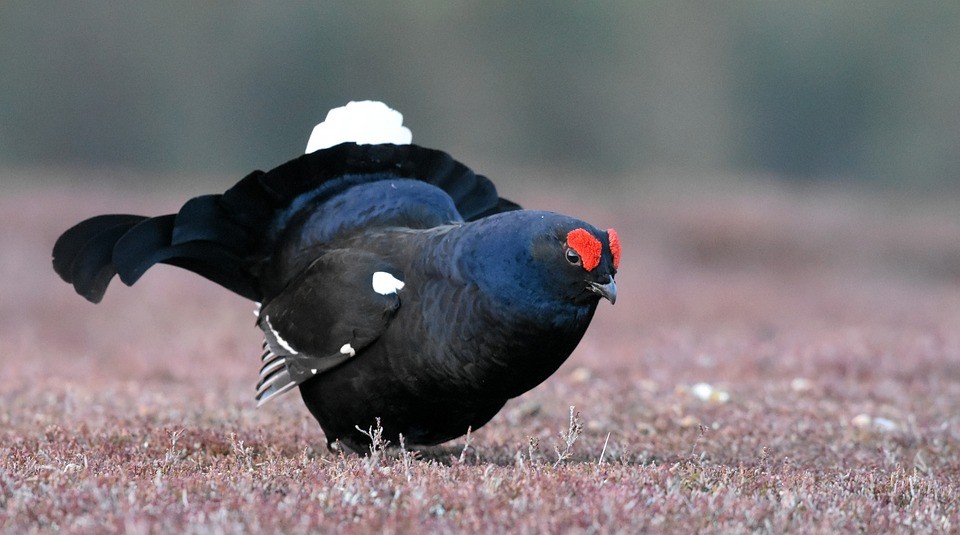Black Grouse
A species of Black and Caucasian Grouse Scientific name : Lyrurus tetrix Genus : Black and Caucasian Grouse
Black Grouse, A species of Black and Caucasian Grouse
Botanical name: Lyrurus tetrix
Genus: Black and Caucasian Grouse
Content
Description General Info
Description
The black grouse is a large bird with males measuring roughly around 60 centimetres (24 in) in length and weighing 1,100–1,250 grams (2.43–2.76 lb), sometimes up to 2,100 grams (4.6 lb), with females approximately 45 cm (18 in) and weighing 750–1,100 grams (1.65–2.43 lb). The cock's fancy plumage is predominantly black with deep-blue hues on his neck and back, which contrasts the white wingline and undertail coverts, as well as red bare skin above each eye. On the other hand, the hen is much drabber and cryptically-colored to blend in easily with the dense undergrowth, especially when nesting. The black grouse, along with the Caucasian grouse, has long outer rectrices (tail feathers) that curl outward and arranged in a way it resembles the frame of a Greek lyre, hence the genus name, Lyrurus. 
Size
60 cm
Life Expectancy
6 years
Nest Placement
Ground
Feeding Habits
Black Grouse dine on a varied diet, including invertebrates, seeds, and plants, showcasing an omnivorous feeding habit. Adapted for ground foraging, they prefer eating during dawn and dusk. A unique preference is their taste for berries during autumn.
Habitat
Black Grouse predominantly occupies transitional zones where woodlands meet open areas, thriving in boreal forest edges, brushwood steppes, or semi-desert regions. Their favored terrain encompasses heaths, moors, and bogs, extending from lowland to alpine elevations. Black Grouse prefers deciduous or mixed forests rich in flora, including birches, and in certain areas, moderately dense coniferous woods.
Dite type
Omnivorous
General Info
Feeding Habits
Bird food type
Distribution Area
Black grouse can be found on open habitats across Europe (Swiss-Italian-French Alps specially) from Great Britain (but not Ireland) through Scandinavia, Estonia and across Russia. In Eastern Europe they can be found in Hungary, Latvia, Lithuania, Poland, Belarus, Romania and Ukraine. There is a population in the Alps, and isolated remnants in Germany, France, Belgium and the Netherlands. It formerly occurred in Denmark, but the Danish Ornithological Society (DOF) has considered it extinct since 2001. The species disappeared from Bulgaria in the 19th century. In Asia, a huge portion of their population can be found in Russia (particularly southern Siberia), though they also inhabit parts of Kazakhstan, Mongolia, China, and possibly Korea. Black grouse are adapted to a extensive array of habitats across Eurasia, though most frequently utilize the transitionary zones between forests and open clearings, especially steppe, heathland, grassland and pasture when near agricultural fields. Depending on the season, they will overwinter in large flocks in dense forests, and feed primarily on the leaves and buds of coniferous and broadleaf trees, such as Scots pine, Siberian larch, silver birch, and Eurasian aspen. Throughout the spring and summer, they tend to favor open spaces to seek potential mates and raise broods, switching their diet to berries, shoots and stems of cranberries, bog bilberries, myrtleberries, and other Vaccinium shrubs. They avoid the most extreme of desert and polar regions. 
Species Status
Although this species has declined throughout most of its range in western Europe, it is not considered to be vulnerable globally due to the large population (global estimate is 15–40 million individuals) and slow rate of decline. Its decline is due to loss of habitat, disturbance, predation by foxes, crows, etc., and small populations gradually dying out. The IUCN implemented a Black Grouse Action Plan 2007–2010. This has looked at local populations that are vulnerable to the extinction vortex. For example, in Styria, Austria. In the United Kingdom black grouse are found in upland areas of Wales, the Pennines and most of Scotland. Best looked for on farmland and moorland with nearby forestry or scattered trees. They have traditional lek sites where the males display. They have declined in some parts of the UK (especially England), having disappeared from many of their former haunts. They are now extirpated in Lancashire, Derbyshire, Exmoor, East Yorkshire, New Forest, Nottinghamshire, Worcestershire, Quantock Hills, Cornwall, Dartmoor, Kent, Wiltshire and Surrey. A programme to re-introduce black grouse into the wild started in 2003 in the Upper Derwent Valley area of the Peak District in England. 30 grouse were released in October 2003, followed by 10 male grouse in December 2004 and a further 10 males and 10 females in April 2005. The programme is being run jointly by the National Trust, Severn Trent Water and Peak District National Park. Conservation groups helping to revive the black grouse include the RSPB and the Game & Wildlife Conservation Trust. In France there has been much work regarding the birds and their risk of flying into ski-lifts. From 1950-2000, local black grouse populations have steadily diminished in Manchuria and northeastern China by about 39%, with birds being most affected (and possibly extirpated) in the Jilin Province. Though the exact causes for local declines remain largely unclear, habitat loss and excess hunting have played a part in the overall reduction. Additionally, climate change might have modified the range and densities of black grouse. Shifts in their location, however, can happen concurrently with the depletion over decades, so short-term research projects may not provide much proof of driving forces behind population alterations. Based on historical info gathered from various sources (including wildlife surveys and scientific papers), aspen, birch, and poplar make up the black grouse's staple diet and habitat. The climate and precipitation during the month of June is also linked to the breeding success of black grouse. 
